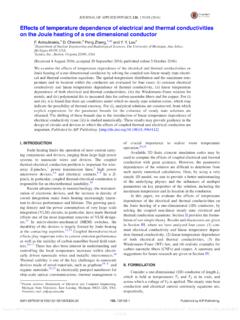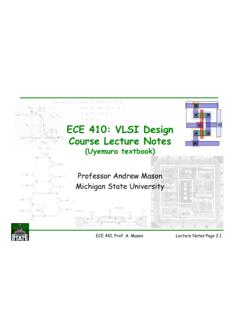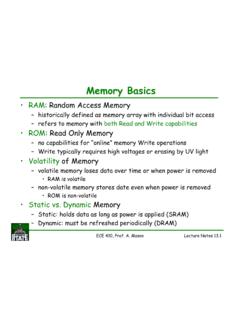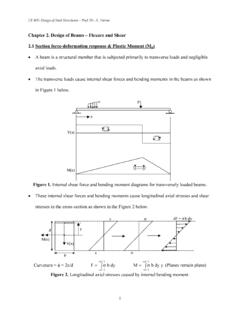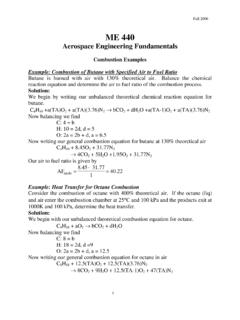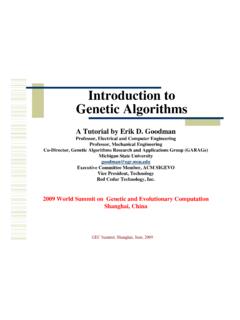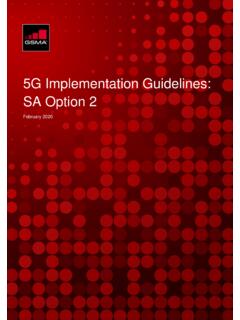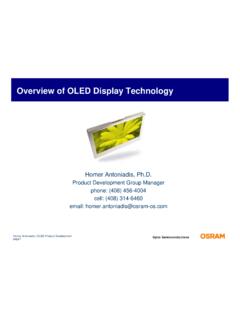Transcription of Introduction to Wireless Communications and Networks
1 1 Broadband Access Wireless Communication of Electrical and Computer EngineeringMichigan State UniversityIntroduction to Wireless Communications and NetworksTongtong LiDept. Electrical and Computer EngineeringMichigan State UniversityEast Lansing, MI Access Wireless Communication of Electrical and Computer EngineeringMichigan State UniversityOutline Overview of a Communication System Digital vs. Analog Communications Examples of Wireless Communication Systems Why Wireless is Different ? Wireless System Architecture Multiple Access Techniques evolution of Cellular Networks (1G ~ 3G) Wireless Local Area Networks (WLANs), Bluetooth and Personal Area Networks (PANs) Ad hoc Networks Topics to be covered in the course3 Broadband Access Wireless Communication of Electrical and Computer EngineeringMichigan State UniversityComponents of a Communication System (1)Figure 1.
2 Communication Systems4 Broadband Access Wireless Communication of Electrical and Computer EngineeringMichigan State UniversityComponents of a Communication System (2) The sourceoriginates a message, which could be a human voice, a television picture or data. The source is converted by an input transducerinto an electrical waveform referred to as the baseband signal or message signal. The transmittermodifies the baseband signal for efficient transmission. The transmitter generally consists of one or more of the following subsystems: a pre-emphasizer, a sampler, aquantizer, a coder and a modulator. Thechannelis a medium through which the transmitter output is sent, which could be a wire, a coaxial cable, an optical fiber, or a radio link, etc.
3 Based on the channel type, modern communication systems are divided into two categories: wireline communicationsystems and Wireless Access Wireless Communication of Electrical and Computer EngineeringMichigan State UniversityComponents of a Communication System (3) The receiverreprocessed the signal received from the channel by undoing the signal modifications made at the transmitter and thechannel. The task of the receiver is to extract the message fromthe distorted and noisy signal at the channel output. The receiver may consist of a demodulator, a decoder, a filter, and a de-emphasizer. The receiver output is fed to the output transducer, which converts the electrical signal to its original form.
4 Transmitters and receivers are carefully designed to overcome the distortion and noise. The Goal of Physical layer Communication System is to transmit information accurately and efficiently(power and spectrum).6 Broadband Access Wireless Communication of Electrical and Computer EngineeringMichigan State UniversityDigital vs. Analog Communications (1) Analog and Digital Signals Messages are digital or analog. Digital messages are constructed with a finite number of symbols. For example, a text file is a digital message constructed from 50 symbols, consists of 26 letters, 10 numbers, a space and several punctuation marks.
5 Similarly, a Morse-coded telegraph is a binary message, implying only two symbols mark and space. Analog messages are characterized by data whose values vary over a continuous range. For example, a speech waveform has amplitudes that vary over a continuous range. A picture is also an analog message. 7 Broadband Access Wireless Communication of Electrical and Computer EngineeringMichigan State UniversityNoise immunity of digital signals8 Broadband Access Wireless Communication of Electrical and Computer EngineeringMichigan State UniversityDigital vs. Analog Communications (2) Noise immunity of digital signals digital data can be recovered without any error as long as the distortion and noise are within the other hand, for an analog message, even a slight distortion or interference in the waveform will cause an error in the received signal.
6 Regenerative repeaters Based on this noise immunity , when transporting a bit stream over a long distance, regenerative repeaters or repeater stations are placed along the path of a digital system at distances short enough to ensure that noise and distortion remain within alimit. The viability of regenerative repeaters is the main reason for the superiority of digital systems over analog ones. Every possible communication can be carried on with a minimum oftwo symbols, , by using a proper binary sequence. In the last 20 years,digital communication gradually replace its analog competitors, and the revolution is now nearly Access Wireless Communication of Electrical and Computer EngineeringMichigan State UniversityInterface of Analog and Digital Systems --A/D and D/A Conversion Sampling TheoremA meeting ground exists for analog and digital signals: conversion of analog signals to digital signals.
7 The backbone that supports the interface is Shannon's Sampling Theorem, which states that if the highest frequency in the signal spectrum is B (in hertz), then the signal can be recovered from its samples, taken at a rate not less than 2B samples per second. Quantizationeach sample is approximated, or round off to the nearest quantized level, the information is thus digitalized. The quantized signal is an approximation of the original one. We can improve the accuracy of the quantized signal to any desired degree by increasing the number of levels. Coding Source coding Convert thequantized signal into binary sequences.
8 Channel codingIntroduce redundancy in a controlled manner to overcome the effects of noise and interferences. MappingMap binary sequence into symbols. Transmission Symbols are applied to a transmitter filter, which produces a continuous signal for transmission over a continuous Access Wireless Communication of Electrical and Computer EngineeringMichigan State UniversityExamples of Wireless Communication Systems Codeless telephones ---use radio to connect a portable handset to a dedicated base station over a distance of a few tens of meters. Paging systems ---Communication systems that broadcast a page from every base station in the network and send brief messages to a subscriber.
9 Cellular telephone systems ---provide a Wireless connection to the PSTN (Public Switched Telephone Network) for any user location within the radio range of a system. Garage car opener Remote controllers for home entertainment equipment Hand-held walkie-talkies Wireless keyboard and mouse Wireless Lan router and adapter ..11 Broadband Access Wireless Communication of Electrical and Computer EngineeringMichigan State UniversityWireless Vs. Wireline Communications ----Challenges in Wireless Communication Systems Wireless channel Have time varying and multipath propagation properties. Communicate over a medium significantly less reliable than wiredphysical layer.
10 Are unprotected from outside signals and interceptions. Multiuser interference (MUI) is a significant problem in Wireless Communications . Has neither absolute nor readily observable boundaries outside of which stations are known to be unable to receive network frames. User Mobility Destination address does not equal to a fixed destination location. Power management ---performance, interference lever and power consumption. Hand-off ---A mobile switches its serving base station while moving from cell to cell. Location management ---tracks the user s movement, support users roaming delivers calls to the user at its current Access Wireless Communication of Electrical and Computer EngineeringMichigan State UniversityTrends on Wireless Communications Rapid growthIn the last few decades, new and cheaper Wireless services are emerging continuously, due to advances in.

